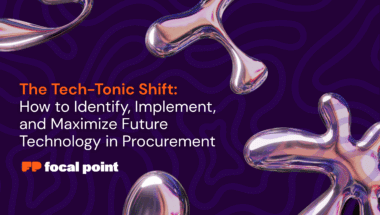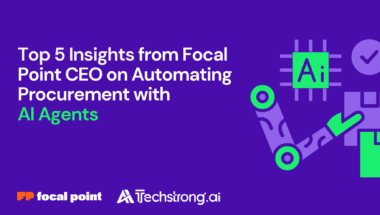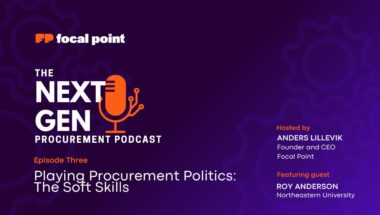What does holistically managing procurement workload look like for procurement professionals?
Focal Point looks at procurement differently than other providers. Rather than optimizing a single procurement task, we look at the end-to-end procurement process, from idea to invoice, helping organizations maximize existing technology solutions. This process includes things like category management, supplier relationship management, strategic sourcing, project management, savings tracking and reporting through one solution.
From facilitating cost reduction and risk management initiatives to optimizing working capital and reducing cycle times, all procurement activities need to be executed with purpose and the appropriate process governance to ensure procurement can claim credit for all that we do.
We love talking about what we have built and what is to come.Today our wholistic management of procurement activities is on display.
History in Managing Procurement
As someone who has worked in procurement for over 25 years, I am very familiar with the crushing workload and velocity of things coming at procurement each day. I am all too familiar with getting random requests from stakeholders through email, IM, phone calls or in meetings and feeling compelled to help everyone with their requests.
What occurred to me is that there was very little I could do to quantify the amount and complexity of the work that my team performed, simply because there was not a digital procurement solution, beyond capturing all procurement projects being worked on at any point in time. For example – things like adding privacy language to hundreds of contracts or doing supplier QBRs were seldom tracked and communicated with stakeholders, and were most often forgotten until and unless an incident occurred.
Unless procurement management is able to clearly articulate the amount of work being done to stakeholders and management, it is assumed that whatever new task comes down the pike can be completed by existing resources without hesitation. And let’s be honest; that isn’t the expectation in most professions. A recruiter would only be expected to work on a certain amount of searches, and a sales person would only a certain amount of accounts. Why is procurement so different?
We drafted this framework to document how to predictably build an overview of the complete demand of procurement. From planned demand to unplanned demand, this framework incorporates resource management and project prioritization, maximizing communication and control.
Planned demand in Procurement
Most procurement organizations perform planning on a regular basis to ensure they can foresee what is coming down the pipeline and allocate resources accordingly. There’s fair awareness to the planned work needing to be completed in a given timeframe. This work type is prioritized because of being able to see what kinds of savings can be forecasted. Most of this work, in my experience, is done through determining contract renewals, talking to major stakeholders about upcoming projects, category planning and major supplier management indicatives, which are normally found in legacy procurement software solutions.
Unplanned demand in Procurement
There will always be unplanned, ad-hoc work coming in from the business that procurement needs to address. The “old” way of work floating around procurement and being assigned to the first available resource is not ideal and often leads to sub-optimal outcomes. A solution, beyond just email and tedious spreadsheets, is needed. There needs to be a structure in place to ensure client requests are resolved through self-service when possible, while remaining work is added to the procurement demand funnel.
The term “intake to procure” has been coined recently, but in my opinion, is one-dimensional and does not truly address what procurement needs in totality, as projects very seldom have a straight path from end-to-end, and many never result in purchases at all.
Handling the procurement demand funnel
Procurement organizations can handle hundreds of projects in a year, and most procurement solutions are not able to track these activities unless they turns into a contract, purchase order or invoice. Even then, there is minimal documentation of cycle times and procurement’s steps taken to fulfill the request.
The first step in this process is to make sure the activities are routed to the right person. We call this project triage, and it is broken down into two steps: category overview and resource planning.
Procurement Category Overview
When assigning projects into the project funnel, it is important to know what goes on in the category already. This can be anything from current and historical projects, preferred suppliers, contract expirations, planned project savings and total spend. With this level of visibility, a manager might discover there is a very similar project underway and could leverage that knowledge to aide the sourcing strategy development.
To best assign work within the procurement organization, visibility of available resources and their relevant experience is crucial. We ensure this visibility by showing on a macro view of which resources are free, and which have experience working on projects in the relevant category, for the same stakeholders, or with the involved suppliers.
Should you want to see the specific projects a resource is working on, you can drill down to view all projects, relevant timelines and projected benefits from the projects in flight.
Procurement Project funnel management
Users involved in workflow execution, and the original requestor, are notified via email or instant messaging about upcoming tasks and progress towards completion. Project owners are notified when tasks slip past expected due dates and management can get their own executive dashboard with high-level statuses and progress towards department KPIs.
Reporting
Since the solution is natively integrated to a variety of legacy sourcing and procurement software solutions, Focal Point is an excellent procurement performance dashboard for users to track a variety of metrics andKPIs. There are multiple standard reports, but also the ability to have custom reports developed based on the available data sets for each client.
Reporting is normally based around the main artifact of procurement, like spend, suppliers, stakeholders, project and contracts, but the interconnectivity of the data allows reports on things like current projects with diverse suppliers included or a supplier’s historical project win/loss ratio.
We love the procurement vertical and talking to practitioners to solve real pain points for our clients. drop us a line or book a meeting, we are eager to help and conquer problems.



